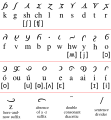File:Kesh aiha LeGuin Always Coming Home alphabet.svg

Size of this PNG preview of this SVG file: 556 × 599 pixels. Other resolutions: 223 × 240 pixels | 445 × 480 pixels | 712 × 768 pixels | 950 × 1,024 pixels | 1,900 × 2,048 pixels | 590 × 636 pixels.
Original file (SVG file, nominally 590 × 636 pixels, file size: 91 KB)
File history
Click on a date/time to view the file as it appeared at that time.
| Date/Time | Thumbnail | Dimensions | User | Comment | |
|---|---|---|---|---|---|
| current | 19:57, 20 December 2018 |  | 590 × 636 (91 KB) | AnonMoos | change "wh" letter shape to be more like in Le Guin's book |
| 11:15, 9 October 2017 |  | 590 × 636 (91 KB) | AnonMoos | {{Information |Description=A basic chart of the ''aiha'' ("new") alphabet for the fictional Kesh language in Ursula K. Le Guin's book ''Always Coming Home'' (ISBN 0-06-015456-X). The Kesh letters are listed in the order of the Kesh alphabet. In each... |
File usage
The following pages on the English Wikipedia use this file (pages on other projects are not listed):
